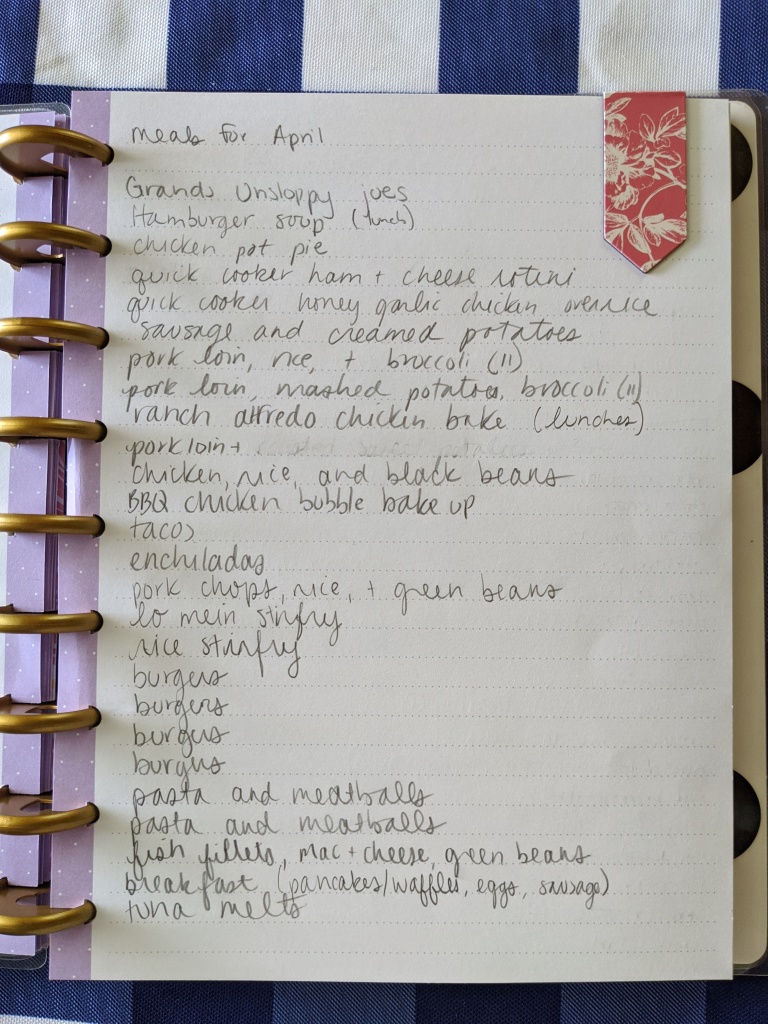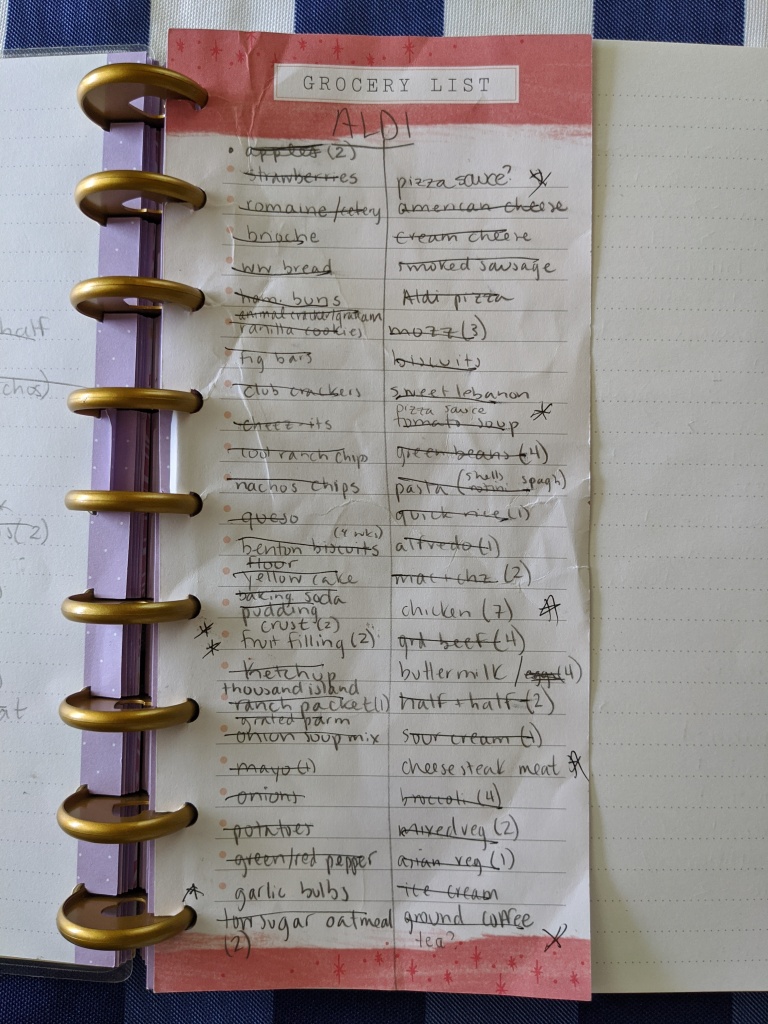I know, I know, it sounds crazy – an inventory of our food?!
But trust me, it’s not crazy. Taking an inventory of your food ensures you know what food you have in your house, saves money through meal planning, and decreases waste (both wasted money and food) – all of which are big wins!
Disclaimer: this post contains Affiliate links and I may make a small amount of money if you decide to purchase from my links. Read my full disclosure and privacy policy here.
So how complicated is this “inventory”?
Taking an inventory of your food does not need to be complicated. Sure, you could set up a Google sheet or Excel system, update it after every meal, and truly have a living food inventory you can share with your significant other, roommates, or the teenager eating you out of house and home.
Or, you can just use a notebook and pencil (no really, use a pencil, I erase a LOT while inventorying food!) for a once-a-month inventory like I do.
I use a Happy Planner that I customized to be our food management system. I already had a cover and a set of rings from a previous year’s planner, so I bought:
And from my HP stash, I also use:
- Magnetic bookmarks
- Bic mechanical pencils (I have used lots of other mechanical pencils but I really prefer my cheap Bics!)
Which means our monthly food inventory looks like this:

While this page is only our chest and refrigerator freezers inventory, we also inventory our refrigerator and pantry. Our “pantry” is actually several regular-sized kitchen cabinets, though we’re hoping to move it to our laundry room someday!
Note: if you don’t have a chest freezer, you can still make this work! Just figure out how much space you have to work with for freezing meat/veggies in your refrigerator freezer. I only do one major shopping trip per month (complete with breaking down and freezing meat for later use) and then small trips for milk/half-and-half, but you could easily split the big trip into two so you have room in your freezer to make it work.
Other than food location, I don’t break down our food into any further categories. It doesn’t need to be any more complicated than that for me to do our monthly meal planning, which is where the big money-saving factor comes in.
Now you know what food you have on hand, so you can start your Upcoming Month Meal Ideas List:

This list will consist of ideas from what you already have in your inventory, and will serve as the catalyst for your grocery list. It can also include things you don’t have the ingredients for, too – especially if you’d like to try some (or all) of the new recipes you’ve been pinning in your free time ? Your goal is to have around 35-40 meals, which will make up your dinners and lunches for the month (plus a few extra).
Next up? Grocery list!
You know what you have, and now you know what additional groceries you need to make your next month of meals. Things are a little complex these days with grocery shopping, so the extra few meals will come in handy in case there is something you can’t find at the grocery store (or perhaps you are like me and aren’t going to spend $7 on a pound of ground beef) so you have a little wiggle room to replace a ground beef-based meal with a chicken-based meal.
I’m a grocery list-junkie, so my hand-written list is organized by the aisles in our Aldi:

This once-a-month shopping list means that we buy bulk ground beef and chicken, and break it down into 12 oz portions for freezing. We do have small supplemental store trips for dairy: milk and half-and-half (and sometimes ice cream, let’s be serious). But! 98% of the month’s food needs are purchased during one grocery trip (to Aldi, for the most part!). Alright, now onto the really fun part:
Monthly Meal Planning
Almost every time I say “monthly meal planning” people look something like this:
But I promise, it is not as complicated as it seems, because you have your trusty food inventory to work from! For lunches, I pick one meal that can make 10 lunches (one for each of us, five work days) and prep it on Sunday for the work week (as we speak, that will be chicken pot pie). Do that one time for each week of the month, and you’re done planning lunches for the month!
Grab a blank calendar for the upcoming month (I like print-a-calendar.com because they waste the least amount of space) and input anything you already have planned: date night take-out? Husband’s birthday dinner? Cookout at your sisters? Cool – now you have three meals planned! Take your meals idea list and input a meal on the remaining day of the month, and that’s it – you’re done! Our April looked like this:

There are some things I take into consideration when making this plan:
- Will any of these meals have leftovers? I try to make our meals not have leftovers, but sometimes they do. If so, I try to make it on Friday and use the leftovers as lunches for the weekend. Or if something I want to make for lunch only makes enough for 4 days, I’ll plan a leftover-having-meal on Thursday so we have lunches on Friday.
- What is the weekend like? Usually we have a late breakfast and skip lunch on the weekends, but will we have a busy day? If so, I don’t want to plan a laborious dinner or something that won’t be ready within a short window of me realizing I’m ravenously hungry after working outside all day!
- Meatless Mondays – We started Meatless Mondays in April 2020 and I’ve really been digging it. A) it’s good for the planet to use less meat, though I love the ag industry AND bacon so I’m not going to give it up entirely and b) it challenges me to come up with something meatless for dinner. Some of our meatless Monday meals have been: grilled cheese and tomato soup, pancakes and eggs, french toast, Mexican skillet (with rice, black, beans, and Ro-tel), and homemade pizza.
And that’s it! Inventory your food, make a meal ideas and grocery list, and put your meals on the calendar. Your process may vary, of course, but I am still confident you can inventory your food to help you meal plan, save money, and reduce waste.


2 thoughts on “3 Reasons to Inventory the Food in Your Home (Plus Monthly Meal Planning Made Easy)”